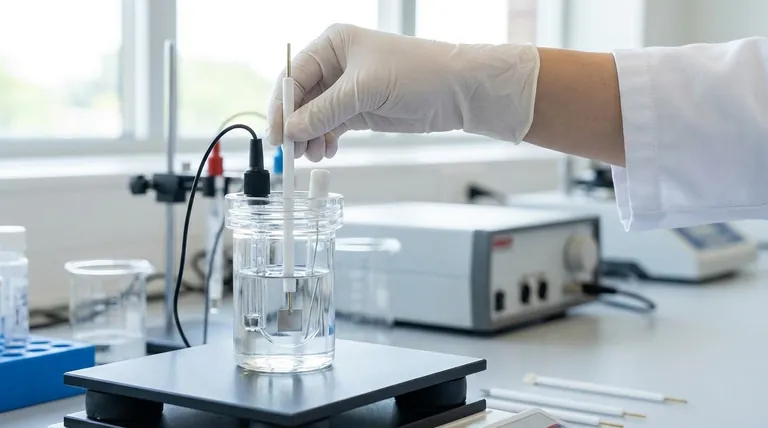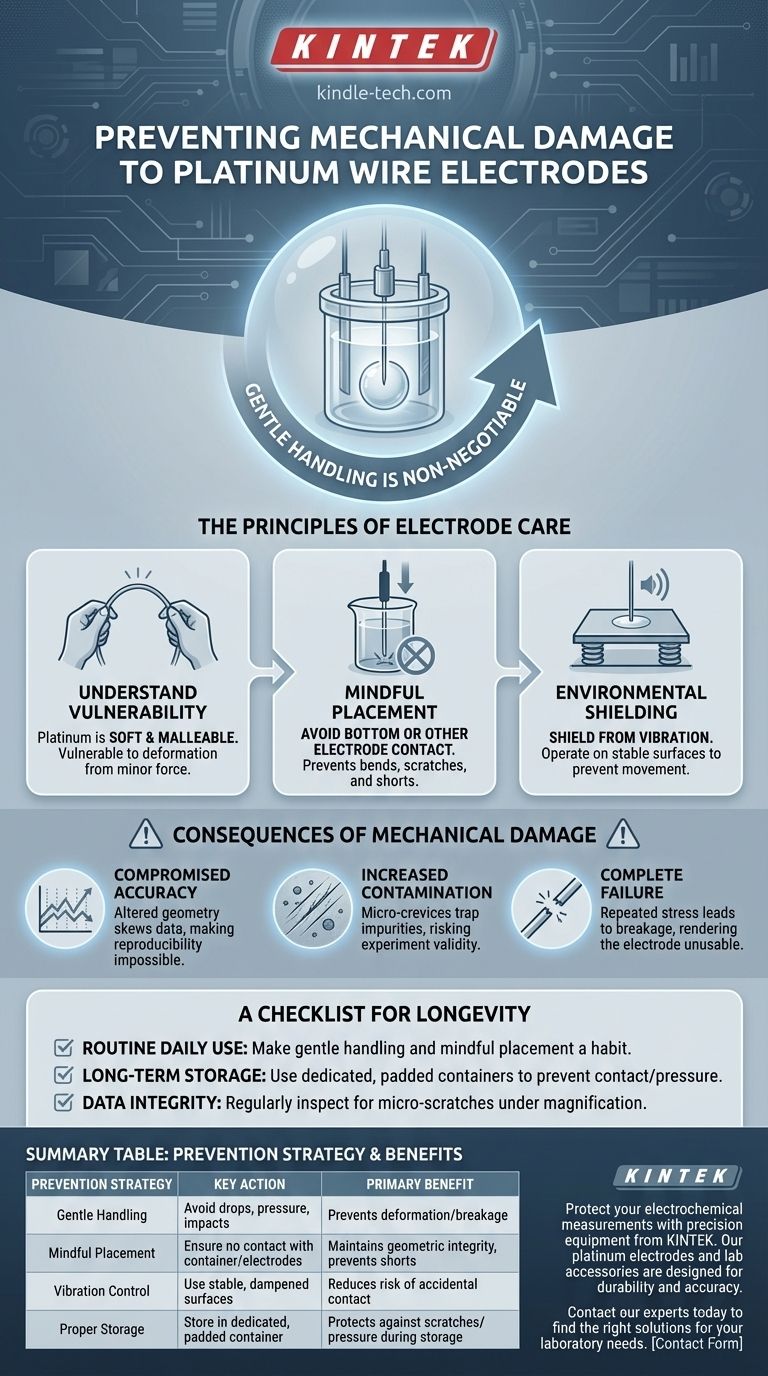In short, preventing mechanical damage to a platinum wire electrode requires a disciplined approach to handling, placement, and storage. Because platinum is a soft and delicate metal, you must avoid applying any excessive force, impact, or pressure that could deform or break the wire during both active use and when it is not in the cell.
A platinum wire electrode's value lies in its precise and consistent surface properties. Protecting it from mechanical damage is not just about preventing breakage; it's about preserving the geometric integrity required for accurate and reproducible electrochemical measurements.

The Principles of Electrode Care
To effectively protect your electrode, it is crucial to understand why it is so susceptible to damage. The core issue is the physical nature of platinum metal itself.
Understand Platinum's Vulnerability
Platinum, despite its chemical inertness, is a very soft and malleable metal. Think of it as being similar to gold; it can be easily bent, scratched, or deformed by forces that would not affect harder materials.
This softness means that even minor impacts, scrapes, or undue pressure can alter the wire's shape and surface texture.
Gentle Handling is Non-Negotiable
The most fundamental rule is to handle the electrode with care at all times. It is a precision instrument, not a rugged tool.
Avoid any dropping, squeezing, or impacts against hard surfaces. This applies to every stage, from removing it from storage to placing it in an electrochemical cell and cleaning it afterward.
Mindful Placement During Experiments
When inserting the electrode into your electrolyte solution, pay close attention to its position. The wire should never touch the bottom of the container or make contact with other electrodes in the setup.
Such contact not only risks bending or scratching the wire but can also create electrical shorts or interfere with your measurement, compromising your results.
Shielding from Environmental Stress
For high-precision measurements, the environment itself can be a source of mechanical stress. Mechanical vibrations from nearby equipment can cause the delicate wire to move and potentially strike other surfaces.
Whenever possible, operate on a stable surface or vibration-dampening table to maintain a steady and safe measurement environment.
Consequences of Mechanical Damage
Failing to protect your electrode has direct consequences that go beyond the cost of replacement. Damage fundamentally compromises the electrode's function.
Compromised Measurement Accuracy
Electrochemical measurements are highly dependent on the electrode's surface area and geometry. A scratch, dent, or bend alters this surface area, which changes the effective current density and skews your data. This makes it impossible to achieve reproducible results.
Increased Contamination Risk
A smooth, polished platinum surface is relatively easy to clean. However, scratches and deformities create microscopic crevices.
These crevices can trap impurities and remnants from previous experiments, which are difficult to remove. This leads to surface contamination and can ruin the validity of subsequent measurements.
Risk of Complete Failure
The most obvious consequence of poor handling is outright breakage. A significant bend or repeated stress can cause the thin platinum wire to snap, rendering the electrode completely unusable and requiring costly replacement.
A Checklist for Longevity
Use this checklist to align your handling protocol with your primary goal.
- If your primary focus is routine daily use: Make gentle handling and mindful cell placement a non-negotiable habit.
- If your primary focus is long-term storage: Store the electrode in a dedicated, padded container that prevents any contact or pressure on the wire.
- If your primary focus is data integrity: Regularly inspect the wire under magnification for any micro-scratches or deformation that could alter its surface area.
Ultimately, disciplined handling is the single most important factor in protecting your investment and ensuring the integrity of your work.
Summary Table:
| Prevention Strategy | Key Action | Primary Benefit |
|---|---|---|
| Gentle Handling | Avoid drops, pressure, and impacts | Prevents deformation and breakage |
| Mindful Placement | Ensure no contact with container or other electrodes | Maintains geometric integrity and prevents shorts |
| Vibration Control | Use stable, dampened surfaces | Reduces risk of accidental contact |
| Proper Storage | Store in a dedicated, padded container | Protects against scratches and pressure during storage |
Protect your electrochemical measurements with precision equipment from KINTEK.
Our platinum electrodes and lab accessories are designed for durability and accuracy, helping you maintain data integrity and avoid costly errors.
Ready to enhance your lab's precision? Contact our experts today to find the right solutions for your laboratory needs.
Visual Guide

Related Products
- Platinum Sheet Electrode for Laboratory and Industrial Applications
- Platinum Auxiliary Electrode for Laboratory Use
- Rotating Platinum Disk Electrode for Electrochemical Applications
- Gold Disc Electrode
- Graphite Disc Rod and Sheet Electrode Electrochemical Graphite Electrode
People Also Ask
- What is the expected lifespan of a platinum sheet electrode? Maximize Your Electrode's Service Life
- What is the most critical guideline for immersing a platinum sheet electrode in an electrolyte? Ensure Accurate Electrochemical Measurements
- What are the specifications of the Platinum-Titanium Functional Electrode? Maximize Electrochemical Performance
- What are the key performance characteristics and applications of platinum sheets? Unmatched Reliability for Demanding Applications
- What is the proper post-treatment procedure for a platinum sheet electrode? Ensure Long-Term Accuracy & Protect Your Investment



















